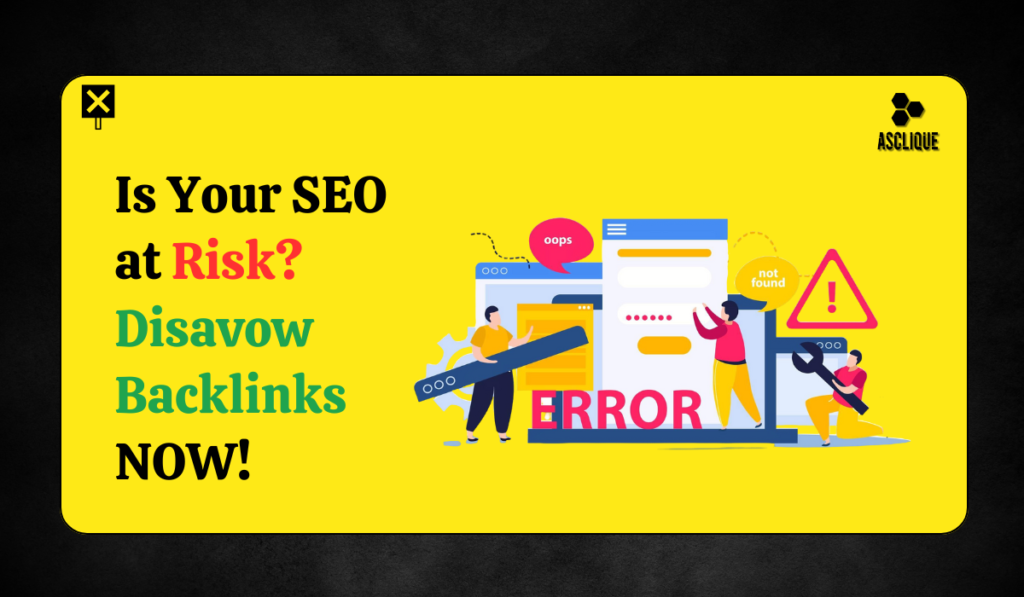Backlinks play a very crucial role to enhance your website authority as well as ranking in SEO. However, not all backlinks are good for you sometimes. You will find that some spam or irrelevant site is linking to your site and affecting your effort of SEO. That is where you require the procedure of disavowing the backlinks. Now let’s learn from this article how to disavow backlinks efficiently and clean up the link profile so that it maintains your reputation for the site.
What Does It Mean to Disavow Backlinks?

Disavow backlinks is basically asking search engines like Google to ignore some backlinks pointing to your site, usually for low-quality or spammy links that could really badly impact your site’s ranking. You make this file listing the links and submit it to Google Search Console in order to help protect your site’s reputation.
Understanding Backlinks: The Good, the Bad, and the Ugly
Now that we have gotten that out of the way, let us begin learning how to disavow backlinks. In simple terms, what we refer to as backlinks is links from other sites directing to your website. Such are very important for the success of search engine optimization. When Google and other such engines evaluate the credibility of any content, backlinks also play a big part.
The Good: Quality Backlinks
Quality backlinks come from other quality rated and relevant websites within your niche. They could be helpful in increasing authority on your website, enhancing traffic, or ranking. Quality can increase credibility to your content by getting links from highly rated news websites, good blogs, etc. According to the report of a survey from Backlinko, a quality backlink will raise the organic traffic level on your site up to 30% in volume.
The Bad: Low Quality Backlinks
On the other hand, low-quality backlinks can cause damage to your SEO. They could be from spammy websites, link farms, or any irrelevant source. The search engines may take this as a sign that your website is not trustworthy enough and could result in penalties and reduced rankings.
The Ugly: Toxic Backlinks
The worst of the worst would be toxic backlinks from banned or hacked sites with otherwise poor reputation. If you possess such links, then your SEO is going to really take some severe hits and can even invite Google to place a manual penalty on the website. The official documents of Google state that too many toxic links drop ranking drastically.
Stat of the Week: MOZ demonstrated that a website that experiences 80-90% toxic backlink loss can suffer a decline of up to 30% in organic traffic.
When Should You Disavow Backlinks?
The knowledge of when to disavow backlinks is important. Here are a few instances when you would need to disavow:
- Google has manually penalized you for unnatural links going to your website.
- You find that a large proportion of spammy links point back to your site and harm your rankings.
- You begin to see an uptick in low-quality links once you have a link building campaign that goes sour.
- A competitor engages in negative SEO, creating harmful links to your site in an attempt to damage your reputation.
How to Disavow Backlinks: A Step-by-Step Guide
Now that we know the importance of knowing how to disavow backlinks, let’s continue.
Step 1: Identify Problematic Backlinks
The very first thing you will learn how to do in relation to disavowing backlinks is to find the problematic backlinks. There are quite a few tools that you can make use of in order to analyze your backlink profile:
- Google Search Console: free, revealing some ideas of links to your website to identify possibly problematic ones.
- Ahrefs or SEMrush: These cost money but will give you an in-depth analysis of the backlinks, and you can see the quality of each link.
How To Check Backlinks:
- Spammy Domains: These are domains with low domain authority and untrustworthiness. You can analyze such using Moz or Ahrefs.
- Evaluate Relevance: Ensure that the links are coming from relevant sites to your niche. Irrelevant backlinks might indicate poor link building.
- Verify Anchor Text: Natural or irrelevant anchor text might also be a cause of concern. Google appreciates diversified and contextually relevant anchor text.
Step 2: Collect Your Backlink Data
After you identify the problematic backlinks, collect the data in an excel sheet. You would require:
- The URL of the linking site
- Target page on your site
- Anchor text used
- Why Disavow
This structured strategy will make subsequent procedures smoother. This will also track the change and efficiency of your disavow process in regard to backlink data.
Step 3: Create a Disavow File
A disavow file is a text file which contains all the backlinks you wish to disavow. To create your file, follow these guidelines:
- File Format: Save it as a.txt file.
- Syntax: Each line must be preceded by either “domain:” followed by the domain name or just the particular URL you wish to disavow. For example:
- domain:spammywebsite.com
- http://example.com/badlink
Step 4: Submit Your Disavow File to Google
Once you have completed your disavow file, it is now time to submit it to Google.
- Open Google Search Console and select your property.
- Open Disavow Links Tool
- Upload your disavow file and click “Submit”.
Important Note: The process of backlinks disavow does not show instantly. Google may take a couple of days to weeks before they actually process the request and display the effects in your rankings. Be patient and watch the results the next couple of weeks.
Step 5: Monitor Your Backlink Profile Regularly
The process of disavowing backlinks is not something you do once. There is a need for the constant monitoring of your backlink profile so that there are no new detrimental links going to your site. Install Google Alerts so you’ll get notified about new links going into your site.
Mistakes to Avoid in the Disavowal of Backlinks
Learning how to disavow backlinks requires avoiding the common mistakes involved in the process.
- Disavowing Too Many Links: Only disavow links that you feel are toxic. Disavowing good backlinks hurts your site’s authority.
- Ignoring Quality Links: Do not mistake a low domain authority for a bad link. Many relevant sites will have lower scores but are beneficial.
- Not Following Up: Once you submit your disavow file, monitor your rankings and traffic. If you do not see improvement, reassess your backlink strategy.
- Failure to Record: Maintain a record of the links you have disavowed. This can be helpful for future audits and to explain changes to clients or stakeholders.
Best Practices to Building Healthy Backlink Profile
Learning how to disavow backlinks is also important, but equally relevant is building a healthy backlink profile. Here’s how to do it properly:
- Quality over Quantity: Focus on getting a handful of high-quality backlinks rather than many low-value backlinks.
- Diverse Link Sources: Source links from different domains, for example, industry-specific blogs, news sites, forums, etc.
- Create Relevant Contents: The quality, informative contents will automatically attract links from high authoritative pages
- Ethical link building Practice: Never do buying links or link farms, as these would later fetch you penalties.
Conclusion
Knowing the backlink disavowal process is important for maintaining a healthy backlink profile and preventing one’s website reputation. You will see that, with constant backlink monitoring and the subsequent actions, your site is well on its way to good standing with the search engines. Remember that quality backlinks are crucial to a successful SEO strategy; thus, building and maintaining a clean and reputable backlink profile should be your top priority. It will save your website in the long run and add value to your overall SEO strategy if you take the proper steps to disavow the harmful links.
FAQs
How long does it take for disavowing links to affect rankings?
It can take many weeks or even more, for the changes to affect the rankings since Google is the one processing the disavow request.
Can I disavow all backlinks at once?
You are not supposed to disavow all links; sometimes, it is worse in terms of site authority in case you do this kind of thing.
Will disavowing links improve my SEO immediately?
No way. It might recover one from penalties, but probably, it will take considerable time to reflect positively, such as improving the site’s rankings and traffic.
How frequently should I review my backlink profile?
Regularly monitor your backlink profile, at least quarterly, to catch any harmful links early on.

